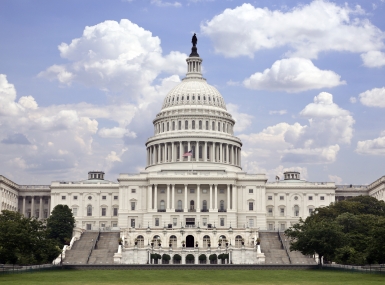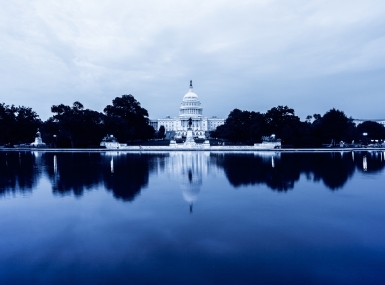U.S. Treasury releases new guidance on Coronavirus Relief Fund
Upcoming Events
Related News

On May 4, the U.S. Department of Treasury released new guidance on the Coronavirus Relief Fund (CRF) that was authorized under the Coronavirus Aid, Relief and Economic Security (CARES) Act (P.L. 116-136). The CRF provides $150 billion in aid for state, county and municipal governments with populations of over 500,000 people to address necessary expenditures incurred due to the COVID-19 public health emergency.
NACo applauds the U.S. Treasury for releasing additional CRF guidance and for including responses to many of the questions submitted by NACo’s membership. Specifically, the guidance provides additional information on CRF administration and eligible expenditures.
Please see below for key questions answered by the U.S. Treasury of importance to counties. To review Treasury’s full guidance, click here.
- The Guidance says that funding can be used to meet payroll expenses for public safety, public health, health care, human services, and similar employees whose services are substantially dedicated to mitigating or responding to the COVID-19 public health emergency. How does a government determine whether payroll expenses for a given employee satisfy the “substantially dedicated” condition?
- The Fund is designed to provide ready funding to address unforeseen financial needs and risks created by the COVID-19 public health emergency.For this reason, and as a matter of administrative convenience in light of the emergency nature of this program, a State, territorial, local, or Tribal government may presume that payroll costs for public health and public safety employees are payments for services substantially dedicated to mitigating or responding to the COVID-19 public health emergency, unless the chief executive (or equivalent) of the relevant government determines that specific circumstances indicate otherwise.
- May a unit of local government that received a payment allowed to transfer funds to another unit of government?
- Yes. For example, a county may transfer funds to a city, town, or school district within the county and a county or city may transfer funds to its state, provided that the transfer qualifies as a necessary expenditure incurred due to the public health emergency and meets the other criteria of section 601(d) of the Social Security Act outlined in the Guidance. For example, a transfer from a county to a constituent city would not be permissible if the funds were intended to be used simply to fill shortfalls in government revenue to cover expenditures that would not otherwise qualify as an eligible expenditure.
- Are recipients required to use other federal funds or seek reimbursement under other federal programs before using Fund payments to satisfy eligible expenses?
- No. County governments may use CRF payments for any expenses eligible under section 601(d) of the Social Security Act outlined in Treasury’s guidance. CRF payments are not required to be used as the source of funding of last resort. However, as noted below in question 7, counties may not use payments from the CRF to cover expenditures for which they will receive reimbursement.
- Are county governments permitted to use CRF payments to pay for unemployment insurance costs incurred by the county as an employer?
- Yes, CRF payments may be used for unemployment insurance costs incurred by the recipient as an employer (for example, as a reimbursing employer) related to the COVID-19 public health emergency if such costs will not be reimbursed by the federal government pursuant to the CARES Act or otherwise.
- May counties deposit CRF payments into an interest-bearing account?
- Yes, so long as a county separately invest amounts received from the CRF, it must use the interest earned or other proceeds of these investments only to cover expenditures incurred in accordance with Section 601(d) of the Social Security Act and Treasury’s guidance on eligible expenses. If a county deposits CRF payments in a government’s general account, it may use those funds to meet immediate cash management needs provided that the full amount of the payment is used to cover necessary expenditures. Fund payments are NOT subject to the Cash Management Improvement Act of 1990, as amended.
- Can CRF payments be used to assist individuals with enrolling in a government benefit program for those who have been laid off due to COVID-19 and thereby lost health insurance?
- Yes. To the extent that the relevant government official determines that these expenses are necessary, and they meet the other requirements set forth in section 601(d) of the Social Security Act outlined in Treasury’s guidance, these expenses are eligible.
- Would providing a consumer grant program to prevent eviction and assist in preventing homelessness be considered an eligible expense?
- Yes, assuming that the recipient considers the grants to be a necessary expense incurred due to the COVID-19 public health emergency and the grants meet the other requirements for the use of Fund payments under section 601(d) of the Social Security Act outlined in the Guidance. As a general matter, providing assistance to recipients to enable them to meet property tax requirements would not be an eligible use of funds, but exceptions may be made in the case of assistance designed to prevent foreclosures.
- May a county recipient create a “payroll support program” for public employees?
- CRF payments may be used to cover payroll or benefits expenses of public employees. However, this is limited to employees whose work duties are substantially dedicated to mitigating or responding to the COVID-19 public health emergency.
- May recipients use CRF payments to cover employment and training programs for employees that have been furloughed due to the public health emergency?
- Yes. This would be an eligible expense if the county determined that the costs of such employment and training programs would be necessary due to the public health emergency.
- May a county recipient use CRF payments to provide emergency financial assistance to individuals and families directly impacted by a loss of income due to the COVID-19 public health emergency?
- Yes, if a county determines such assistance to be a necessary expenditure. For example, this assistance could include a program to assist individuals with payment of overdue rent or mortgage payments to avoid eviction or foreclosure or unforeseen financial costs for funerals and other emergency individual needs. This assistance should be structured in a manner to ensure as much as possible, within the realm of what is administratively feasible, that such assistance is necessary.
- Can CRF payments be used to assist impacted property owners with the payment of their property taxes?
- Fund payments may not be used for government revenue replacement, including the provision of assistance to meet tax obligations.
- Can CRF payments be used for capital improvement projects that broadly provide potential economic development in a community?
- In general, no. If capital improvement projects are not necessary expenditures incurred due to the COVID-19 public health emergency, then CRF payments may not be used for these projects.However, CRF payments may be used for the expenses of, for example, establishing temporary public medical facilities and other measures to increase COVID-19 treatment capacity or improve mitigation measures, including related construction costs.The Guidance includes workforce bonuses as an example of ineligible expenses but provides that hazard pay would be eligible if otherwise determined to be a necessary expense.
- Is there a specific definition of “hazard pay”?
- Hazard pay means additional pay for performing hazardous duty or work involving physical hardship, in each case that is related to COVID-19.
Additional resources
- For the U.S. Treasury’s COVID-19 landing page, click here.
- For U.S. Treasury’s Coronavirus Relief Fund guidance landing page, click here.
- For a list of eligible units of local government to receive CRF payments click here.
- To review the U.S. Treasury’s methodology for Coronavirus Relief Fund payments, click here.
Attachments
Related News

County Countdown – Dec. 15, 2025
Every other week, NACo's County Countdown reviews top federal policy advocacy items with an eye towards counties and the intergovernmental partnership.

U.S. Congress passes reconciliation bill: What it means for counties
On July 3, the U.S. Congress passed sweeping budget reconciliation legislation.

U.S. Senate passes amended reconciliation bill text: What it means for counties
On July 1, the U.S. Senate narrowly passed their version of sweeping budget reconciliation legislation.